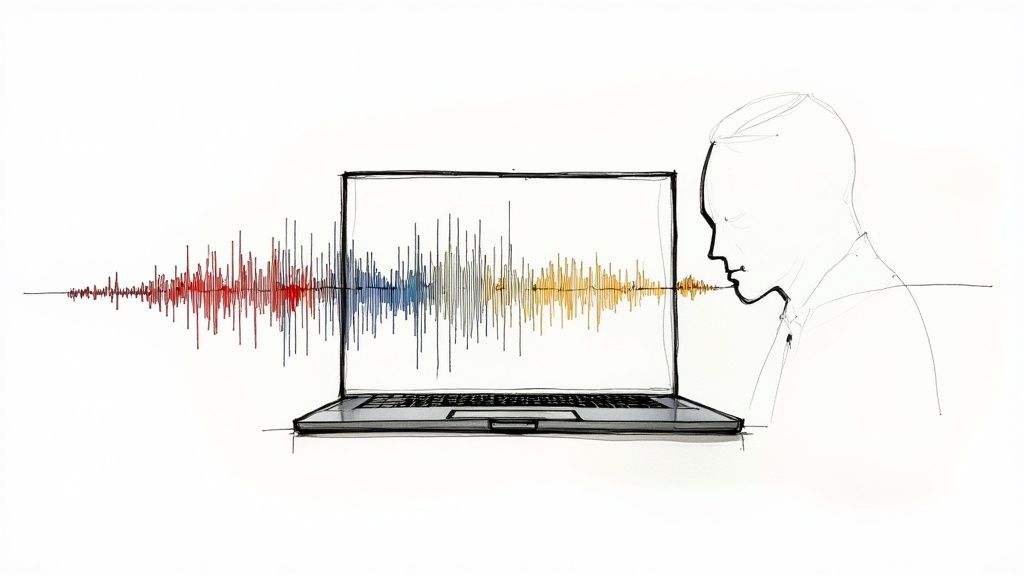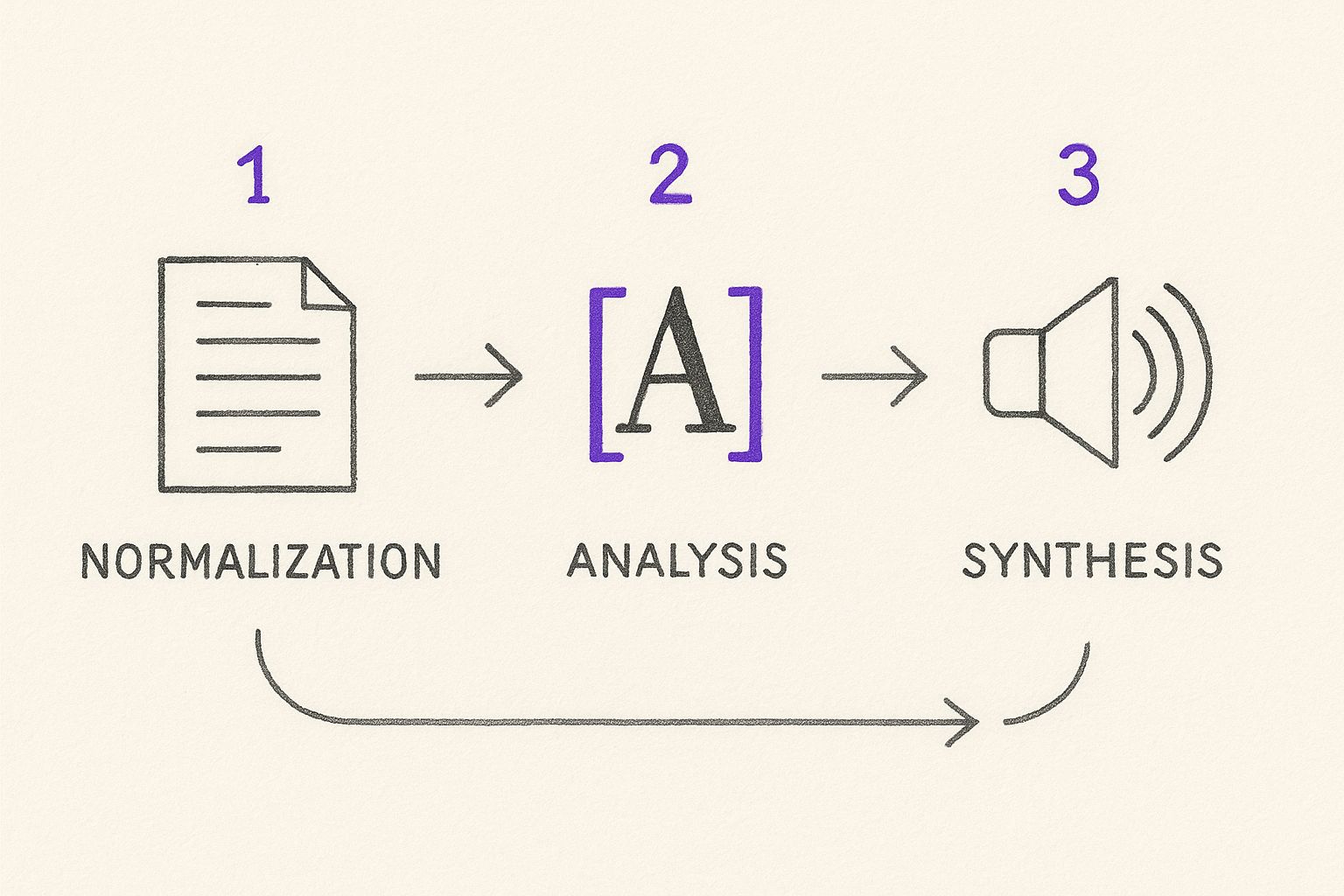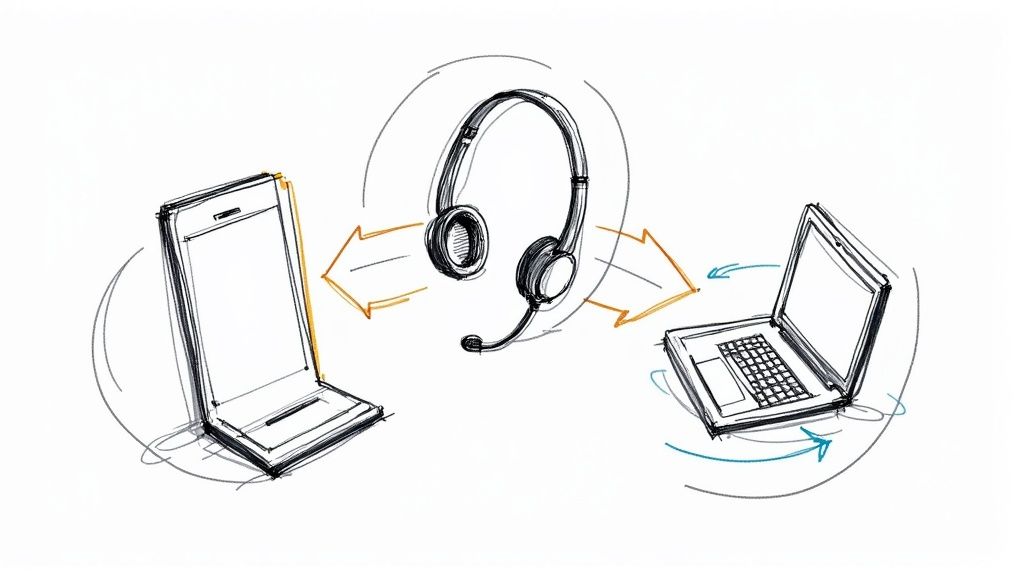Your Ultimate Guide to Text to Speech Technology

If you’ve ever used GPS navigation or listened to an audiobook, you’ve experienced text to speech (TTS). It’s the magic that instantly turns any written word into natural, human-like audio. And let's be clear: the robotic, monotone voices of the past are long gone.
The Reality of Modern Text to Speech

A quick glance at a modern TTS platform like Verbatik shows just how simple and powerful the process has become. What used to be a clunky, complicated system is now an intuitive interface where you can generate high-quality audio in minutes.
At its heart, text to speech is a type of speech synthesis that gives your words a voice. Think of it as an automated narrator on call, ready to read articles, scripts, or any digital text out loud. This isn't just a novelty anymore; it's a must-have for content creators, businesses, and developers who want to make their content more engaging and accessible.
The technology has come so far, moving beyond basic pronunciation to capture the subtle intonation, emotion, and pacing of a real human speaker. You can learn more about this incredible journey in our article covering the evolution of text to speech technology.
This leap in quality is fueling some serious market growth. The global TTS market was valued at around USD 4.55 billion in 2024 and is expected to explode to USD 37.55 billion by 2032. That’s a compound annual growth rate of roughly 30.2%, all driven by the massive demand for voice-enabled apps and content. For a deeper dive, check out the data on the global text to speech market growth on databridgemarketresearch.com.
Overcoming Traditional Barriers
Not long ago, creating high-quality audio was a huge headache. It meant hiring voice actors, booking expensive studio time, and slogging through hours of editing. For bigger projects, the costs could spiral out of control. Modern TTS platforms were built to smash these barriers.
Today’s TTS technology has completely leveled the playing field for audio creation. It replaces complex, costly production with a simple, scalable workflow that anyone can pick up in minutes.
Platforms like Verbatik push this even further with features that were once unimaginable. With unlimited text to speech, you’re no longer counting characters or worrying about the bill for long-form content like e-learning courses or audiobooks. You have the freedom to experiment and produce audio at any scale without the financial stress.
On top of that, advanced voice cloning lets you create a unique, consistent audio identity for your brand. Instead of settling for generic stock voices, you can generate a digital replica of a specific voice, making sure all your audio content sounds uniquely yours. This powerful duo of unlimited generation and custom voices makes professional-grade audio more accessible than ever before.
How AI Teaches a Computer to Speak
Ever wonder how a machine actually learns to talk? It's a fascinating process, and in many ways, it's a lot like how a person learns to read a book out loud for the first time. This isn't just about playing back recorded words; it’s a smart, three-stage process driven by artificial intelligence.
First up, the AI has to make sense of the text. This initial step is called normalization. The system scans the raw text and cleans it up, turning all the numbers, abbreviations, and symbols into words. So, "St." becomes "Street," "$100" turns into "one hundred dollars," and "2024" is read as "twenty twenty-four." This ensures the computer knows exactly what it’s supposed to say.
From Words to Sounds
With the text cleaned up, the AI moves on to linguistic analysis. It's here that the system breaks down the words into their basic phonetic parts, sort of like sounding out words syllable by syllable. It identifies the phonemes—the smallest units of sound in a language—and figures out the correct pronunciation, where to put the stress, and the right intonation for every sentence. This is the secret sauce that keeps the voice from sounding flat and robotic.
This handy infographic breaks down the core three-step flow, from raw text to the final speech you hear.

This process shows how AI methodically translates written symbols into the fundamental building blocks of human speech before creating the final audio.
Generating a Human-Like Voice
The last and most amazing stage is synthesis. Using sophisticated deep learning models, the AI takes all that phonetic information and generates a brand-new audio waveform from scratch. A key part of this involves complex neural networks, which are inspired by how neural networks mimic the human brain. These models have been trained on thousands of hours of human speech, which is why they can produce voices that are not just clear, but also full of life and emotion.
This leap from just stitching together pre-recorded sounds to generating completely new audio with neural networks is what separates today's TTS from the clunky computer voices of the past. It’s why AI can now capture subtle emotions and lifelike pacing.
This entire intelligent process is the foundation for creating incredibly high-quality audio. Platforms like Verbatik then take this core technology and build powerful, practical features on top of it. Take voice cloning, for instance. It uses the exact same synthesis process but fine-tunes the neural network on one person's voice to create a flawless digital copy.
This efficiency is also what makes Verbatik's unlimited text to speech possible. By perfecting each stage—from normalization right through to synthesis—the system can pump out huge volumes of audio content quickly and without breaking the bank. The old barriers that made large-scale audio production a nightmare are gone.
The technology has become incredibly accessible. You can learn more about what text to speech technology is and how it works in our detailed guide. It’s this smart workflow that has made modern TTS a go-to tool for creators everywhere.
The Strategic Benefits of Using AI Voice
It’s cool to understand how AI learns to speak, but the real magic happens when you apply it to get actual results. Adding high-quality text to speech to your projects isn't just a tech upgrade—it's a smart move that opens up new ways to work, new audiences to reach, and new creative doors to walk through. The payoffs are huge, touching everything from accessibility and user engagement to production costs and global scale.
By turning text into audio, you instantly make your digital content available to a much wider group of people. This is a massive win for inclusivity. In fact, one of the biggest reasons text-to-speech technology exists is to help individuals with disabilities. According to the World Health Organization, over 2.2 billion people around the world have vision impairment or blindness, which can make reading a real challenge. TTS closes that gap, giving them an essential way to access information and education. You can check out more on the market drivers for TTS technology on expertmarketresearch.com.
This goes beyond just checking a box for compliance; it's about genuinely connecting with anyone who wants your content, no matter how they need to access it.
Supercharge User Engagement
In a world filled with digital distractions, grabbing and holding someone's attention is half the battle. Audio content is a fantastic way to break through that noise and pull people in. Instead of just reading a blog post, your audience can listen to it while they're on their commute, at the gym, or just multitasking around the house. That flexibility keeps them tuned in for way longer.
Adding an audio option can seriously cut down your bounce rates and boost the time people spend on your page—both are strong signals of a great user experience. For apps, websites, and e-learning courses, a voice feature turns a flat interface into something dynamic and interactive. With Verbatik's unlimited text to speech, you can turn every single article, lesson, or product description into audio without ever hitting a character limit. Your entire platform becomes listenable.
Slash Production Time and Costs
Let's be honest, creating voiceovers the old-fashioned way was a pain. You had to find and hire voice actors, book studio time, and then sit through endless recording and editing sessions. It was not only expensive but also painfully slow, which made it nearly impossible to create audio at scale or push out quick updates.
AI voice generation completely flips the script. A task that used to take days or even weeks can now be done in minutes, cutting production costs by up to 90% or more.
This kind of speed is a game-changer for teams of any size.
- Actionable Insight for Marketers: A/B test a dozen different ad scripts with various voices without needing a single reshoot. With Verbatik's unlimited text to speech, you can generate endless variations to find the perfect message and tone, all within an hour.
- Actionable Insight for Educators: Update course materials on the fly without having to track down and re-hire a voice actor. When a compliance rule changes, simply edit the text and regenerate the audio in minutes, ensuring content is always current.
- Actionable Insight for Developers: Generate dynamic in-app narration in real-time, reacting instantly to user actions. This creates a more interactive and supportive user experience without complex audio management.
Tools like Verbatik put this power at your fingertips with a massive library of voices and instant audio generation. And with an unlimited text to speech model, you have the freedom to experiment and tweak as much as you want to get it just right, without the budget anxiety. You can find more ideas on leveraging text to speech technology for business growth in our dedicated guide.
Achieve True Global Reach
Finally, AI voice helps you talk to the entire world. If you want to break into new international markets, you have to localize your content, and audio is a critical piece of that puzzle. Modern TTS platforms give you hundreds of voices across dozens of languages and accents, letting you create authentic-sounding, localized audio for any corner of the globe.
Think about it: you could launch a new product video and, at the same time, release versions with native-sounding voiceovers in Spanish, German, and Japanese. That kind of localization builds serious trust and makes your brand feel at home anywhere. With Verbatik, you can even use voice cloning to keep your brand's unique vocal identity consistent in every language, ensuring you sound polished and professional no matter where your audience is.
Practical Applications for Text to Speech

Knowing the benefits of text to speech is one thing, but seeing it solve real-world problems is where the lightbulb really goes on. This isn't just a neat piece of tech; it’s a practical tool that businesses and creators are using every single day to get more done, faster and better.
Let's skip the generic list and jump into a few actionable scenarios where TTS makes a massive difference.
Speeding Up Creative Workflows
Imagine a digital marketing agency scrambling to create a video ad campaign for a hot new e-commerce brand. Their plan? A/B test ten different ad scripts to find the winner. The old way of doing this would have been a logistical nightmare—ten separate voiceover sessions, each one costing time and money.
With a platform like Verbatik, that entire process changes. The team can generate all ten voiceovers in under an hour. They just pick a few different voices from the library, paste in their scripts, and hit download. This ability to produce at scale without watching the budget spiral out of control is a direct benefit of Verbatik's unlimited text to speech model.
Making Education and Training More Agile
Now, think about an e-learning company building a compliance course for a global corporation with offices in five different countries. The material has to be consistent, but the delivery needs to feel local. Hiring voice actors for five different languages would blow their budget and push back the launch by weeks.
Instead, the instructional designer finalizes the script in English and uses TTS to create high-quality, native-sounding voiceovers in Spanish, German, French, and Japanese.
The real win here is agility. When a small policy detail changes a month later, they don’t need to track down and re-hire five actors. They just tweak the text and regenerate the audio in minutes, keeping the training perfectly up-to-date everywhere.
This approach gives every employee a polished, professional experience, no matter where they are. The company saves a ton of money and gets its training out the door faster, showing a clear ROI from adding TTS to their toolkit.
Powering Modern User Experiences
Text to speech is already deeply embedded in the technology we use every day, often in ways we don't even notice. The automotive and smart device industries, for example, rely heavily on TTS to create safer, hands-free interfaces. The car industry alone is projecting a 14.8% CAGR in TTS adoption as it builds systems that let drivers get information without taking their eyes off the road.
The table below shows just how widespread these applications have become across different sectors.
Text to Speech Applications Across Industries
| Industry | Primary Application | Key Benefit |
|---|---|---|
| Marketing & Advertising | A/B testing ad scripts, creating video voiceovers | Rapidly produce and test creative variations at scale |
| E-Learning | Localizing training modules, updating course content | Cost-effective localization and instant content updates |
| Publishing | Creating audiobooks and narrated articles | Opens up new revenue streams and improves accessibility |
| Customer Service | Powering Interactive Voice Response (IVR) systems | More natural and efficient automated customer interactions |
| Technology | In-app voice guidance, hands-free device control | Enhances user experience and improves product safety |
| Accessibility | Screen readers for visually impaired users | Makes digital content accessible to a wider audience |
From automated phone menus to your favorite news app reading an article aloud, the goal is always to create a smoother, more engaging experience for the user. It's not just about converting text to audio; it’s about making information more accessible and interactions more human. For a deeper look, guides on integrating Speech to Text into your daily workflow to boost productivity show the broader impact of voice tech.
Whether you're a marketer testing ad copy or a developer building a new app, Verbatik has the right tools for the job. The unlimited text to speech plan removes the financial guesswork, while features like voice cloning let brands maintain a unique, consistent sound everywhere they show up.
How Verbatik Solves Key TTS Challenges
While modern text to speech technology is incredible, it’s not always a smooth ride. Anyone who has produced audio content knows the typical frustrations: unpredictable costs, tight character limits, and the struggle to create a unique sound for your brand. These roadblocks can bog down projects and make it nearly impossible to scale up your audio production.
This is exactly where a smarter platform design changes the game. We built Verbatik from the ground up to tackle these headaches head-on. The entire experience is built around two core pillars: unlimited text to speech and instant voice cloning. These aren't just extra features; they’re direct answers to the biggest hurdles in audio creation.
Breaking Free from Character Limits
One of the biggest gripes with most TTS platforms is the pay-per-character model. It puts you in a constant state of budget anxiety. Every single word, every sentence, every little revision—it all adds to the bill. This forces you to be stingy with your words and second-guess your scripts.
Think about creating an e-learning course or turning a long blog post into an audio version. With a character-based plan, you're always watching the meter. It discourages experimentation and makes big projects feel financially risky for a lot of people.
Verbatik's unlimited text to speech model throws that entire problem out the window. It frees you completely from the tyranny of counting characters, so you can generate as much audio as you need.
This unlimited approach transforms text to speech from a metered utility into a true creative tool. You can iterate freely, A/B test different scripts, and produce hours of high-quality audio for projects of any size without worrying about a surprise invoice.
This is a fundamental shift in thinking. Instead of asking, "Can we afford to make this?" the question becomes, "What amazing audio can we create next?"
Crafting a Unique and Consistent Brand Voice
Another huge challenge is simply standing out. When everyone is using the same stock voices from the same libraries, all the content starts to sound the same. It's tough to build a memorable brand identity when your audio sounds generic. Your voice should sound uniquely yours.
This is where voice cloning is a game-changer. Voice cloning tech lets you create a perfect digital copy of a specific voice. Verbatik makes this process ridiculously fast and simple, allowing you to generate a custom voice that feels right for your brand’s personality.
Here’s why that creates such a powerful audio identity:
- Unmatched Consistency: You can use the exact same voice across all your content, whether it’s a YouTube ad, a podcast intro, or your company's phone system. That consistency builds familiarity and trust.
- Authentic Connection: A custom voice just feels more real and personal than a generic one, helping you build a stronger bond with your listeners.
- Scalable Personalization: Once your voice is cloned, you can use it to generate unlimited content. No more booking the original voice actor for every tiny update or new script. This makes scaling your audio strategy both efficient and affordable.
By combining the creative freedom of an unlimited plan with the branding power of a unique cloned voice, Verbatik delivers a complete solution for modern audio production. You can read more about how Verbatik provides an efficient text to speech solution for voice-overs and more on our blog. This powerful combination helps you create more content, build a stronger brand, and get a much better return on your entire audio strategy.
Creating Your First AI Voiceover in Minutes
Theory is one thing, but actually hearing the power of text to speech for yourself is what makes it all click. Let's walk through just how easy it is to create your first professional-grade audio file with Verbatik. The whole process is incredibly simple, taking you from a script to a polished voiceover in just a few steps.
As you can see, you don't need to be a sound engineer to get started. Following along with the tutorial shows just how fast and intuitive modern TTS really is.
Step 1: Sign Up and Choose Your Plan
First things first, you'll need to create a Verbatik account. We offer a few different plans, but the goal is to find one that matches what you need to create. A huge difference with Verbatik is our unlimited text to speech model—unlike other services that nickel-and-dime you for every character, you can generate as much audio as you need without watching the clock.
This is a game-changer for anyone producing content at scale, from e-learning courses to video ads and audiobooks. It gives you the freedom to experiment and iterate without the budget anxiety that usually comes with big audio projects.
Step 2: Select the Perfect Voice
Once you're logged in, you’ll find a huge library of over 600 AI voices in more than 140 languages and accents. This is where the fun begins, as you get to define the personality of your project. You can filter by language, gender, age, and even specific use cases to find the right voice in seconds.
Don't just pick the first voice you hear! Take a minute to preview a few different options. You're looking for one that truly matches the tone of your script. A warm, friendly voice might be perfect for a podcast intro, while a crisp, authoritative one is a better fit for a corporate training module.
Step 3: Paste and Format Your Text
With your voice picked out, it's time to bring in your script. Just copy and paste it directly into the text editor. For the best-sounding results, a little formatting can make a big difference. Double-check your punctuation—the AI uses commas, periods, and question marks as cues for pacing and natural intonation.
You can also use the built-in studio controls to direct the performance:
- Rate: Speed the voice up or slow it down.
- Pitch: Adjust the pitch to hit different emotional notes.
- Pauses: Add short breaks for dramatic effect or to let a point sink in.
Step 4: Generate and Download Your Audio
After you've dialed in the settings, hit the "Generate" button. In just a few seconds, Verbatik does its magic and produces a crystal-clear audio file. You can preview it right there in the editor to make sure everything sounds perfect.
Once you’re happy with it, you can download the file as either an MP3 or a WAV. WAV files are uncompressed and deliver the absolute highest audio quality, which is ideal for professional video or audio productions. If you're curious about the difference, check out our guide on when to download a WAV file for your projects.
And just like that, you've created your first AI voiceover. It's ready to go.
Common Questions About Text to Speech
As you start exploring the world of text to speech, you’ll find the same questions pop up again and again. Getting good answers is key before you jump in, so let’s tackle the big ones head-on.
How Realistic Do AI Voices Actually Sound Today?
Forget everything you think you know about robotic, monotone computer voices from a decade ago. We've moved on. Modern AI voices have made a massive leap forward, thanks almost entirely to a shift toward neural text to speech (Neural TTS).
These new AI models learn from enormous libraries of human speech, picking up on all the tiny details—the pauses, the pitch changes, the rhythm—that make a voice sound truly alive. The best TTS voices today don't just say the words; they deliver them with context and emotion. The difference is like comparing an old flip phone picture to a 4K video. This quality makes the audio genuinely engaging, perfect for anything from a quick video narration to a full-length audiobook.
Is Text to Speech Affordable for Large Projects?
This is a huge one, especially if you're creating long-form content like training courses or podcasts. In the past, TTS services that charged by the character or word could get wildly expensive. Every script revision or new episode would have you nervously checking your budget.
That's the exact headache Verbatik was built to eliminate.
With Verbatik's unlimited text to speech plan, that financial stress just goes away. You can generate hour after hour of premium audio without ever hitting a character limit or watching costs pile up. It’s a model that finally makes TTS both affordable and scalable for any project, big or small.
This gives you the freedom to experiment, create more content, and stay focused on your message instead of counting characters. It’s a real, practical way to scale up your audio without draining your wallet.
What Is Voice Cloning and Is It Hard to Do?
Voice cloning sounds like something out of a sci-fi movie, but it’s actually pretty straightforward: you create a perfect digital copy of a specific person's voice. All you need is a short audio sample. The AI analyzes its unique qualities—the tone, the accent, the pacing—and learns to replicate it flawlessly.
It’s the ultimate tool for creating a signature sound for your brand. And while the tech is complex, using it isn't. Verbatik offers instant voice cloning that makes the whole thing surprisingly easy. You don't need a fancy studio or a sound engineering degree. The platform walks you right through it, and in minutes, you have a unique voice model ready for any script you give it.
This opens up a ton of possibilities:
- Keep Your Brand Consistent: Every ad, every customer service message, every internal training video can feature the same familiar, trusted voice.
- Scale Personalized Content: Imagine creating endless voiceovers for different campaigns without having to book the same voice actor over and over.
- Own Your Audio Identity: Your brand can have a voice that’s truly its own, setting you apart from competitors using the same old stock voices.
When you pair the freedom of unlimited generation with the power of a unique cloned voice, you have everything you need to build a standout audio strategy.
Ready to unlock the full potential of your content with lifelike AI voices? With Verbatik, you get unlimited text to speech, instant voice cloning, and a full suite of AI content creation tools. Start creating for free today at verbatik.com.
